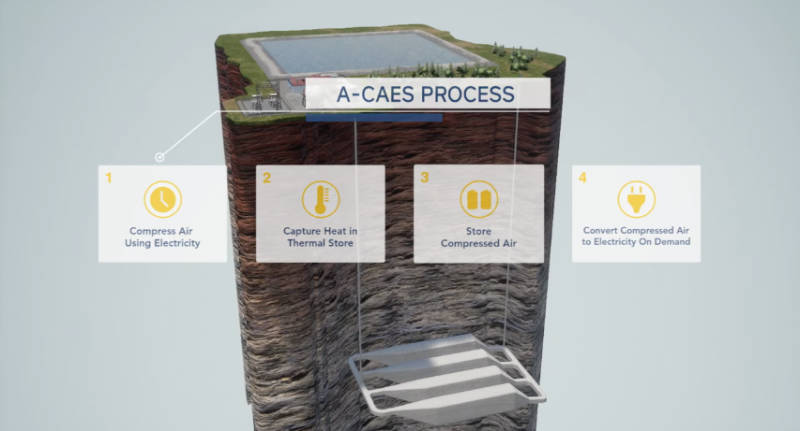Molten salt, pumped hydro, green hydrogen – non-battery energy storage is ready to take its shot

Non-battery energy storage is all set to release its pent up power. Pic: Devonyu via Getty Images
Net zero emissions is the holy grail of climate scientists who fear that the failure to achieve it by 2050 would have dire consequences, some of which are already been felt by people living in low lying regions and islands.
However the road to achieving this goal is a long and arduous one as the world shifts from fossil fuels to low or zero emissions sources of renewable energy.
Where electricity generation is concerned, achieving the first 70% to 80% is actually the easy part.
Economies of scale thanks to a massive acceleration of take up has meant that solar – both rooftop and grid-scale – has become a fairly inexpensive way of meeting our electricity requirements when the sun is shining.
Along with the use of onshore wind, lithium-ion (or other types) batteries and geographic diversity (having solar farms and wind farms spread out over a large area makes it more likely there’s sun or wind somewhere), this could place us well within 82% of our power needs this decade, according to Climate Energy Finance director Tim Buckley.
It is the last 18% that will take longer and cost more, though he noted that considering energy from the perspective of baseload power is an outdated concept from a decade ago.
“The concept is completely different today because you are going to have negative power prices 20% or 30% of the time and that changes everything,” Buckley said.
“It’s the value of peaking power that is key to the average for the sector. The consumer is only interested in the average, but producers have to be interested in the components.
“I want to use solar and wind when it’s sunny and windy because it will be very cheap and when it is not windy or sunny for the last 30%, I can afford to systematically pay $70 to $120 per megawatt hour (MWh) because I’m getting the first 70% really cheap.”
He pointed out that using this concept make offshore wind viable, which along with other potential ideas such as batteries on wheels – using the batteries in electric vehicles – could take us that little bit further on the path towards weaning our electricity grid off fossil fuels.
“All of a sudden we’re talking about firming for the last 10% of the grid, not 30% or 40%, and the scaling up of the batteries will play a huge part,” Buckley explained.
“Pumped hydro plays an important seasonal role. It plays an important role in delivering the reliability and decarbonisation we need for the last five or 10%.”
He added that while the role for non-battery energy storage (of which pumped hydro is arguably one of the most mature options) is limited, it would still play a role as there is real value in diversity of supply as the Russian invasion of Ukraine and its impact on European gas supplies made very clear.
Non-battery energy storage
That roundabout route takes us to the topic of energy storage.
Batteries have long taken centre stage when it comes to energy storage, at least where electricity is concerned. There is good reason for that given they are able to store large amounts of power in a small space and can be quickly deployed.
While lithium-ion batteries have been the predominant battery type by a substantive margin – read here for some of the alternatives – concerns have been raised about whether we can ramp up production of lithium feed (from brines or spodumene), lithium chemicals and batteries.
That’s even without going into the other elements required, though worries about cobalt have eased thanks to the introduction of new chemistries. (Buckley pointed out that Bloomberg’s cobalt forecast from just three years ago was three times higher than its current forecast.)
Some of that lithium demand apprehension might have been alleviated by Fastmarkets flagging that while the market might be tight, supply will nonetheless be able to keep up. But it still behooves us to look at the alternatives, some of which might actually be more useful for heating (another big contributor to greenhouse gas emissions).
It’s hydropower, of sorts
Pumped hydro is arguably the most mature and established of all non-battery energy storage solutions.
The concept is simple – use energy from the grid or renewable energy (preferably) during low demand periods to pump water from a lower reservoir to a higher one, which effectively converts the latter into a giant battery.
Power can then be generated by flow the water through a hydroelectric turbine (a la hydropower) into the lower reservoir.
This can generate power quickly when needed, making it suitable for peaking power, or generate large amounts of electricity over a long period.
Australia already has several pumped hydro projects operating, including Wivenhoe and Shoalhaven, and opportunities for more are being considered or planned for the major Battery of the Nation project in Tasmania and Snowy Hydro 2.0 in New South Wales.
Its biggest flaw is the sheer scale required with Buckley pointing out that the price of developing Snowy Hydro 2.0 has blown out by 100%.
“These are big infrastructure projects, so we’ve got to be aware of cost inflation,” he added.
Salt, sand and sun
The other major form of non-battery energy storage is thermal.
At its core, it simply means heating or cooling a medium which will then release its stored heat energy over time to generate heat or potentially electricity.
The concept itself is simple and many Australian homes already use it in the form of solar hot water systems where the energy of the sun is used to heat water that is then stored in a tank, which can then be dispensed for hot showers etc.
Where it gets a little more complicated is when projects get clever about the means of heating and/or the material used to store the heat.
This has given rise to fancy concepts such as using banks of mirrors to focus the sun’s rays to heat molten salt, which has far greater heat output then water, and using the superheated salt to drive turbines for power generation.
A notable example of this is the troubled Crescent Dunes Solar Energy Facility, which suffered design, construction and technical problems that resulted in its developer going bankrupt, though operations have restarted under Nevada public utility NV Energy.
In Australia, the Australian Renewable Energy Agency (ARENA) has conditionally approved in late October $45m in funding to construct a 200MW/1,600MWh fuel free energy storage facility using a compressed energy system on the site of a disused mine at Broken Hill.
The proposed $652m project will compress air during times of low electricity prices, storing it in subsurface reservoirs and releasing it through a turbo-expander to generate electricity during times of high demand and high energy prices.

A much simpler system can be found at the Vatajankoski power plant area in Finland, which hosts a sand-based energy storage solution which (again) uses low cost electricity to warm up the sand by resistive heating.
It then discharges hot air that is circulated in the sand by means of a heat exchange for the district heating system where it is pumped around homes, offices and even the local swimming pool when electricity prices are high.
Hydrogen, actually energy storage
The last is green hydrogen. While much of the rhetoric surrounding hydrogen makes it out to be some kind of green fuel, the reality is that it is really a form of non-battery energy storage.
Like all other forms of energy storage (battery or otherwise), the basic premise is simple.
Take electricity at its cheapest point of the day and use it to run electrolysers that turn water into hydrogen and oxygen.
Store hydrogen in tanks and it can be used directly as a fuel or run through fuel cells to generate electricity.
Of course there are other ways to store the hydrogen with some proposing the use of depleted natural gas or oil reservoirs while others are proposing new ideas such as Tempo proposing the use of solid metal hydrides that require far less space than pressurised tanks.
Related Topics

UNLOCK INSIGHTS
Discover the untold stories of emerging ASX stocks.
Daily news and expert analysis, it's free to subscribe.
By proceeding, you confirm you understand that we handle personal information in accordance with our Privacy Policy.








